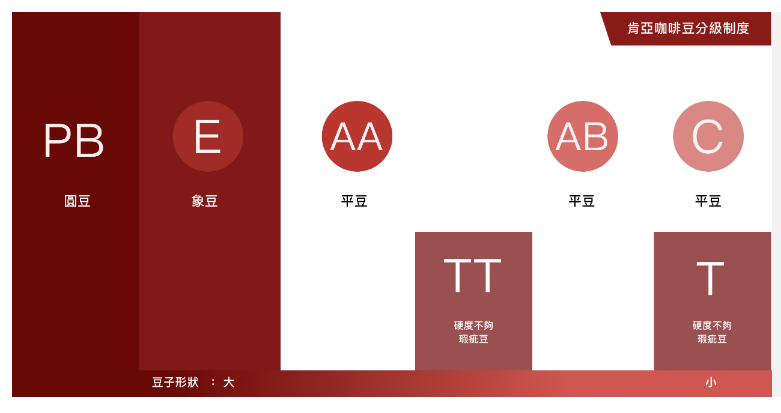Kenya aa: what is Kenya aa and what is the baking degree
As a coffee drinker, you should often see such terms as Kenyan coffee or even Kenyan AA in coffee shops. We may know that Kenya refers to the origin of coffee beans, but what does AA mean? In this article, let's talk about Kenya Coffee and how it is graded.
Kenya is a country located in East Africa and near the Indian Ocean. Because it was colonized by Britain, it established a coffee planting park in Kenya in the 19th century, as well as a sound cultivation and quality management system.
Kenyan coffee beans are usually grown at an altitude of 1500-2000 meters above sea level. Most coffee beans are grown by small farmers and are harvested twice a year. Kenya coffee beans are characterized by fruit flavor, rich taste and acidic flavor, but in addition, in order to improve the bad habit of small farmers being exploited, Kenya has established a very perfect auction system and successfully got rid of the situation in which small farmers were often exploited in the past.
Kenya coffee beans: AA (AA+), AB, C, PB, TT, T, E
E: Elephant beans (elephant bean), which is generally a hybrid of Malagogi and maragogype.
Usually there are two seeds in a coffee fruit, affixed face to face, one of which will be flat, called flat bean, or mother bean or double bean. E is in the growth process of these two seeds, the body sticks together and becomes a large-looking bean. Because it is a naturally occurring variation, the number is very small.
AA, AB, C: iron pickup, from large to sub-district
AA is the largest bean, followed by AB, and C refers to smaller beans.
PB: less round beans (bean-shaped berries)
Due to the small number of round beans, it is also precious by comparison.
TT, T: lighter beans
TT and T grade beans due to light weight, hardness does not meet the official standards, so another grade, TT grade coffee bean size between AA and AB, T grade between C grade coffee bean size, are due to the hardness is not light enough, so another grade classification.
The most common coffee shop is Kenya AA or Kenya AA+,. The next time you see a falling coffee name in a coffee shop, do you already know how to read it? In fact, as long as you remember to see the word Kenya and think that it is a fruity coffee bean, the rest is just a distinction between particle size and weight.

Important Notice :
前街咖啡 FrontStreet Coffee has moved to new addredd:
FrontStreet Coffee Address: 315,Donghua East Road,GuangZhou
Tel:020 38364473
- Prev

Classification of different grades of washed Kenya coffee beans
Under the influence of British colonization, Kenyans love coffee. In Kenyan restaurants, drinks have to be paid extra, but coffee is provided free of charge. The history of Kenyan coffee can be traced back to the end of the 19th century, when the British established a sound cultivation and quality control system. After Kenya became independent in 1964, the coffee industry continued to develop on the existing basis, and now it is a world-famous high-quality product.
- Next

Kenya aa: what is Kenya aa and what is the baking degree
As a coffee drinker, you should often see such terms as Kenyan coffee or even Kenyan AA in coffee shops. We may know that Kenya refers to the origin of coffee beans, but what does AA mean? In this article, let's talk about Kenya Coffee and how it is graded. Kenya is a country located in East Africa near the Indian Ocean. Because it was colonized by Britain, it was established in the 19th century.
Related
- Beginners will see the "Coffee pull flower" guide!
- What is the difference between ice blog purified milk and ordinary milk coffee?
- Why is the Philippines the largest producer of crops in Liberia?
- For coffee extraction, should the fine powder be retained?
- How does extracted espresso fill pressed powder? How much strength does it take to press the powder?
- How to make jasmine cold extract coffee? Is the jasmine + latte good?
- Will this little toy really make the coffee taste better? How does Lily Drip affect coffee extraction?
- Will the action of slapping the filter cup also affect coffee extraction?
- What's the difference between powder-to-water ratio and powder-to-liquid ratio?
- What is the Ethiopian local species? What does it have to do with Heirloom native species?

